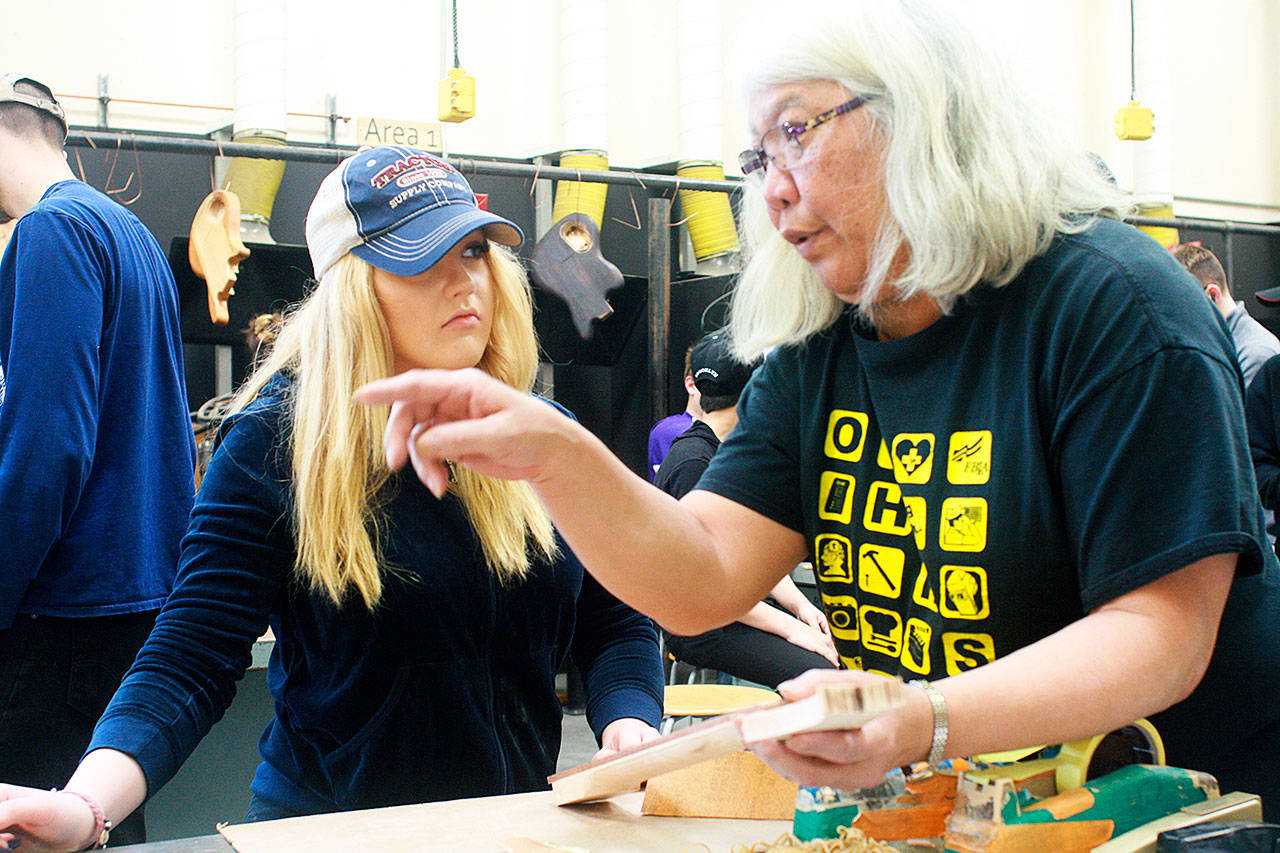Rylee Truex, Mikhaela Cortez and Olivia McDaniel entered the shop filled with boys, grabbed their partially completed guitars and set to work sanding and shaping.
They are the only girls in the guitar-building class at Oak Harbor High School.
Sitting at separate tables from each other, if the boy/girl ratio bothered them, they didn’t show it.
“I like hands-on learning, and I think it’s really cool to build a guitar,” said Truex, who is also in auto shop. “This is my third high school, and this is the only one that does it.”
Ray Cone, director of the career and technical education, or CTE program, for Oak Harbor Public Schools, said he tries to expose as many students as possible to all the vocational opportunities that his program offers.
One way that he hopes to attract potential students is to make his courses relevant to the students’ futures by lining up the course content with professional certificate and college programs, he said
“My goal is to expose the students to as many opportunities as possible and to have strong programs,” Cone said.
Yet many of the classes are dominated by male students.
“Typically the woods classes, the metal classes, the automotive class, the computer science class — they’re dominated by the male population, Cone said.
“But we do have … about 20 percent females that go into those non-traditional (subjects) — they at least get exposed.”
On the flip side, the sports medicine, nursing and culinary arts programs tend to attract more girls that boys.
Cone said he would like to see a more even mix of girls and boys in all of the career and technical education classes.
To that end, Cone said he has built up the middle school CTE program, attempting to entice the younger students, which tend to be more adventurous in the classes they try.
In order to spark more female interest in the boy-dominated classes, Cone has already employed a couple strategies.
The high school hosted a series of girls days, where middle-school students were given the opportunity to try out several of the CTE offerings. Cone’s program also sponsors field trips for female high school students to receive exposure to women in non-traditional lines of work, like engineering and mathematics.
These offerings yielded a modest return, but Cone said he’s still devising plans to engage more students.
“One of the things that I hope will reach out to more female students, is I’ve got two exploring CTE classes that we’re staring next year,” he said.
Throughout the semester, students will experience 30 days of instruction in a variety of subjects, designed as snapshots of the field to facilitate student exposure to more opportunities.
The first CTE sampler includes drafting, robotics and automotive, while the second such class replaces drafting with video.
“Being that they’re exploring, it might not be as intimidating, because I have talked to several of the girls,” he said. “The ones that thrive are very strong-willed in those areas, but others are often intimidated.”
Some of the intimidating factors Cone identified include the fact that several of the classes can get very noisy and that a few of the classes could potentially ruin a new set of clothes.
“A lot of places have coveralls that you can put on,” he said. “But girls, right now, if they’re gonna be in wood shop or in auto, they don’t want to wear a super nice dress or any nice clothes.”
The clothing concern extends to boys, too, Cone said, leading him to believe that another way the CTE program can best suit the needs of his students would be to acquire coveralls for the participants.
Yet that many uniforms would cost a pretty penny, and beyond a grant or a creative way to justify them in a budget, the coveralls will have to wait.
Dr. Lance Gibbon, superintendent of Oak Harbor Public Schools said that budgeting for the CTE program can be tricky.
The district has prioritized CTE by ensuring that the high school has state-of-the-art equipment and facilities for students to be competitive in their fields directly after graduation, he said.
For example, students can learn everything they need at the high school to earn a welding or nurse’s aid certificate.
Gibbon also noted the award-winning and highly touted culinary arts and DECA programs.
“One of the strengths of Oak Harbor, and this has been a history on our district, has been our career and technical education programs,” Gibbon said.
Gibbon said the district must find ways to justify the CTE classes by ensuring that they meet core requirements for the state.
Students at the high school are now having to meet the state’s “Core 24” requirement, which necessitates each student to earn 24 core credits in order to graduate.
CTE classes aren’t typically classified as a core requirement, but with some creative thinking, the district has dual-certified a few of them. Computer science, for instance, fulfills a core science requirement.
As district officials find more way to dual-certify the CTE classes, Gibbon said that “those programs are really meeting the needs of students in a way that’s not happening in other places.”



